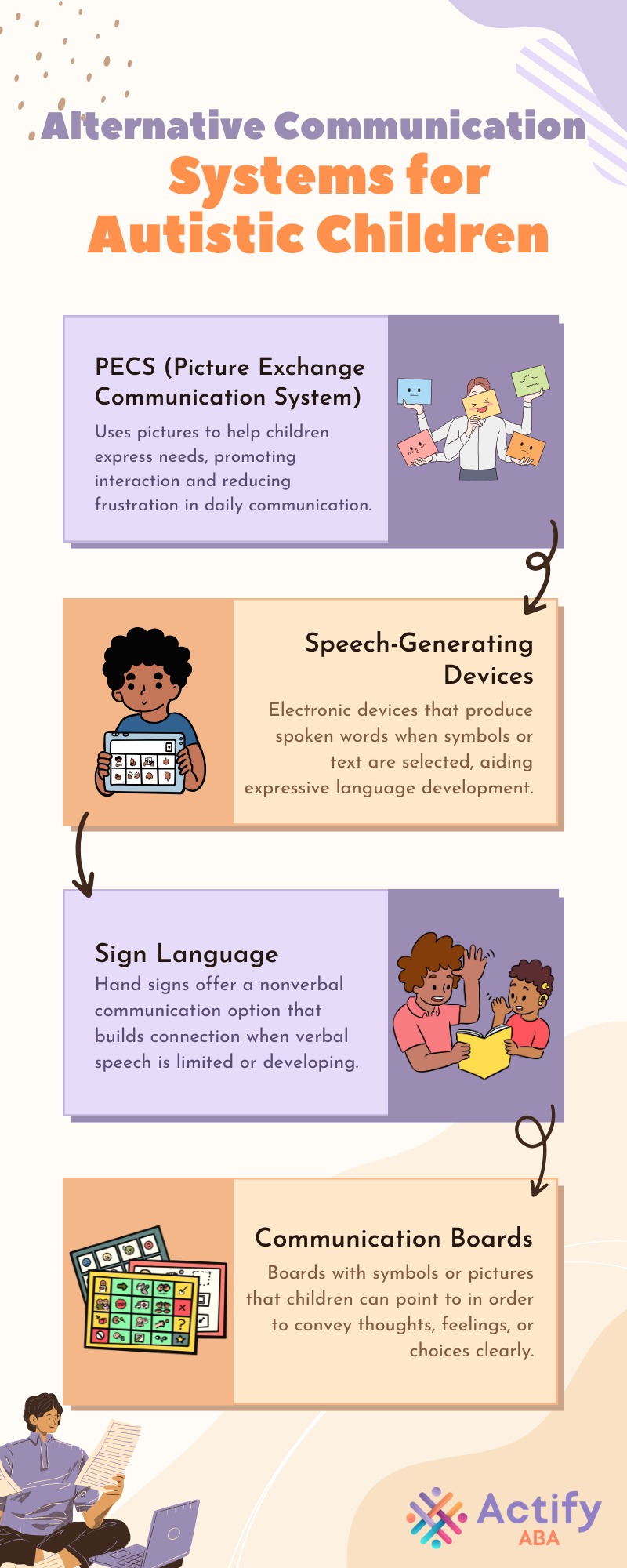
Key Points:
- Children with autism often express themselves in diverse and nontraditional ways, including through body language, echolalia, or assistive communication tools.
- Understanding a child’s unique communication profile helps reduce frustration and strengthens relationships with caregivers, teachers, and peers.
- Visual aids, behavior supports, and speech-language therapy can enhance meaningful interactions and self-expression.
Children on the autism spectrum may not communicate the same way as their peers, and that’s okay. What matters most is understanding how they express themselves—verbally, nonverbally, or behaviorally—and adapting accordingly.
According to studies, around 30% of autistic individuals are nonverbal, while others might have limited or delayed speech. This diversity in how communication shows up is what makes the term “communication styles in autism” so important for parents and caregivers to understand.
In this article, we’ll go over the different communication methods often seen in autistic children, explore why they exist, and discuss how families can better respond to and support them. Whether your child uses speech, gestures, pictures, or devices to communicate, learning to recognize and work with their communication preferences builds stronger bonds and fosters independence.
What are the Communication Styles in Autism?
Communication styles in autism refer to the different ways autistic individuals express thoughts, needs, and emotions, including verbal speech, gestures, visuals, behavior, or devices. These styles are often shaped by sensory processing differences, developmental delays, or social challenges.
Understanding these methods isn’t about “fixing” how a child communicates—it’s about meeting them where they are. Some children may speak fluently but struggle with back-and-forth conversation. Others may rely entirely on nonverbal methods. Many use a combination of styles depending on the situation.
How Does Autism Affect Verbal Communication?
Verbal language is often delayed or develops differently in children on the spectrum. Even when speech is present, how it’s used may seem unusual to those unfamiliar with autism. Some children speak in a monotone voice, use scripted phrases, or repeat what others say without responding directly.
This doesn’t mean they aren’t trying to connect. In fact, many children with autism use spoken language in specific, meaningful ways that align with their needs or sensory comfort. Recognizing the intent behind speech—however limited or different—is a key part of understanding autism communication styles. This same principle of honoring individual communication needs also applies to how we support autistic students in learning environments, as we explore in our article Effective Classroom Accommodations for Autistic Students.
What are Nonverbal Communication Styles in Autism?
Many autistic children rely on nonverbal forms of communication, either exclusively or alongside speech. These methods include facial expressions, body posture, gestures, and even behavior. Interpreting these cues requires attentiveness and familiarity with the child’s patterns.
Sometimes, what appears to be “acting out” is actually a form of communication—a way of expressing discomfort, sensory overload, or an unmet need. When caregivers can decode these messages, they can reduce frustration and support more peaceful, successful interactions.
Key nonverbal communication forms include:
1. Gestures
Many autistic children use gestures like pointing, waving, or leading a caregiver’s hand to communicate needs or interests, especially when verbal language is limited or unreliable.
2. Facial Expressions
Smiles, frowns, grimaces, or lack of expression can indicate mood or discomfort, though interpreting these signs often requires close familiarity with the child’s individual communication style.
3. Proximity and Touch
Moving toward someone might signal a desire for closeness or help, while pulling away or avoiding touch may reflect sensory sensitivities or social anxiety.
4. Behavioral Cues
Nonverbal behaviors such as meltdowns, pacing, or withdrawal can serve as powerful communication tools, signaling emotional distress, sensory overload, or unmet needs.
5. Eye Contact Patterns
Avoiding eye contact or using fleeting glances may help some autistic children manage sensory input while still participating in social exchanges in their own way.
Parents may find that their child uses more nonverbal communication during certain times of the day, around unfamiliar people, or when overwhelmed. Consistency in interpreting these signals helps build trust and emotional safety.
How Do Assistive Communication Tools Support Autistic Children?
When spoken communication is limited or unreliable, many children benefit from Augmentative and Alternative Communication (AAC) systems. These include anything from picture cards and speech-generating devices to tablet-based apps and sign language.
These tools allow children to express preferences, ask questions, or participate in group settings more comfortably. It’s important to remember that AAC doesn’t hinder verbal development; in fact, it often supports and encourages speech by providing a structure for language.
Examples of AAC systems used in autism include:

Introducing AAC tools early and consistently can help reduce communication-related stress and promote independence.
Why is Echolalia Common in Autism?
Echolalia is a frequent speech pattern in children with autism, where a child repeats words or phrases they’ve heard, either immediately or later on. Though it may seem meaningless at first, echolalia often serves a purpose—expressing emotion, requesting something, or self-regulating.
There are two types of echolalia:
- Immediate echolalia – Repeating words right after hearing them.
- Delayed echolalia – Recalling and repeating phrases heard earlier, sometimes days or weeks later.
Understanding echolalia as a stage of language development rather than a barrier can help parents respond more supportively. Some children use repeated lines from shows or routines as a way to interact or soothe themselves.
How Can Parents Support Their Child’s Communication Style?
Each child has a unique communication profile shaped by their strengths, preferences, and needs. Recognizing, respecting, and working with these preferences is more effective than trying to make a child fit into a standard communication mold.
Parents can create an encouraging environment by modeling clear language, using visual supports, and avoiding pressure to “speak correctly.” The goal is meaningful connection—not perfect grammar. When parents validate and respond to all types of communication—spoken or not—they send a powerful message: “I hear you.”
What Role Do Social Communication Challenges Play?
Communication in autism is often impacted by difficulties in social reciprocity—knowing when to take turns in a conversation, understanding personal space, or recognizing nonverbal cues. These aren’t “rude” behaviors—they reflect neurological differences in how social information is processed.
For example, a child might dominate a conversation with a favorite topic, not to be inconsiderate, but because it’s what they’re passionate about. Another might not make eye contact because it feels overwhelming, not because they’re disinterested.
Supporting social communication means offering tools and modeling behavior without shaming or forcing conformity. With guidance and practice, many children develop increased confidence in navigating these areas over time.
Get the Support You Need With ABA Therapy
Understanding the many communication styles in autism helps caregivers meet children where they are. Whether your child speaks, signs, uses devices, or communicates through behavior, they deserve tools and environments that honor their way of connecting with the world.
At Actify ABA, we offer ABA therapy in Maryland that supports children in developing meaningful, functional communication. Our team works closely with families to build customized strategies that reduce frustration and foster independence, whether through verbal language or alternative systems like AAC or visual supports.
Contact us today to learn how our ABA therapy services in Maryland can support your child’s unique communication journey. Let’s help them feel seen, heard, and understood—on their own terms.
